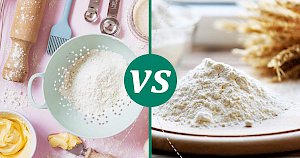Rye Flour vs Wheat Flour: Calories & Nutrition Showdown


Rye flour vs Wheat flour
Nutrition Facts
Serving size:
change
5g10g15g20g30g40g50g60g80g100g120g140g160g180g200g220g250g300g350g400g450g500g600g700g800g900g1000g
1oz2oz3oz4oz5oz6oz7oz8oz10oz12oz15oz20oz25oz30oz35oz40oz50oz
Amount Per Serving:
Serving size:
change
5g10g15g20g30g40g50g60g80g100g120g140g160g180g200g220g250g300g350g400g450g500g600g700g800g900g1000g
1oz2oz3oz4oz5oz6oz7oz8oz10oz12oz15oz20oz25oz30oz35oz40oz50oz
Amount Per Serving:
Rye Flour vs Wheat Flour 100g Compare
| per 100g | Rye flour | Wheat flour |
|---|---|---|
| Calories | 357 | 364 |
| Carbohydrates | 76.68 g | 76.31 g |
| Fat | 1.33 g | 0.98 g |
| Dietary fiber | 8 g | 2.7 g |
| Protein | 9.82 g | 10.33 g |
| Water | 11.4 g | 11.92 g |
| Calcium | 13 mg | 15 mg |
| Iron | 0.91 mg | 1.17 mg |
| Magnessium | 32 mg | 22 mg |
| Potassium | 224 mg | 107 mg |
| Sodium | 2 mg | 2 mg |
| Vitaminium B1 (Thiamine) | 0.331 mg | 0.12 mg |
| Vitaminium B2 (riboflavin) | 0.09 mg | 0.04 mg |
| Vitaminium B3 (Niacin) | 0.8 mg | 1.25 mg |
| Vitaminium B6 | 0.234 mg | 0.044 mg |
| Vitaminium B9 (Folic acid) | 0.023 mg | 0.026 mg |
| Vitaminium E | 0.83 mg | 0.06 mg |
Discover the Unique Qualities of Rye and Wheat Flour
When it comes to baking and cooking, choosing the right type of flour can make all the difference. Rye flour and wheat flour are two popular options, each with its own set of unique characteristics and nutritional benefits. But beyond just their nutritional content, these flours have interesting histories and applications that make them stand out in the pantry.
The Rich History and Uses of Rye Flour
Rye flour, known for its deep, rich flavor, has been a staple in European cuisine for centuries. It's particularly famous for its role in making rye bread, which ranges from the dense, dark loaves of Germany to the light, crispbread of Scandinavia. What sets rye flour apart is its adaptability to poorer soils and harsher conditions, making it a vital crop in regions where other grains might not thrive. Nutritionally, rye flour is a powerhouse, offering more fiber per serving compared to wheat flour. This makes it a favorite for those looking to add more fiber to their diet.
Wheat Flour: The Versatile Staple
On the other hand, wheat flour has a more neutral taste and is incredibly versatile, making it a staple in kitchens around the world. It's the go-to flour for everything from bread and cakes to pastas and pastries. Wheat's adaptability as a crop has allowed it to become a global food staple. In terms of nutrition, wheat flour provides a slightly higher protein content than rye, making it a preferred choice for high-rise bread and baked goods that need a strong gluten network.
Comparing Nutritional Values
When we dive into the nutritional aspects, both flours have their merits. Rye flour contains 357 calories per 100 grams, boasting a higher fiber content of 8 grams, which is beneficial for digestive health. It also has a slightly lower protein content at 9.82 grams. On the other hand, wheat flour contains 364 calories per 100 grams, with a fiber content of 2.7 grams and a slightly higher protein content of 10.33 grams. These nutritional differences can influence your choice depending on your dietary needs and baking requirements.
Which Flour is Better for You?
The answer depends on what you're looking for in your diet and baking endeavors. If you're aiming for higher fiber intake and a distinctive taste in your baked goods, rye flour is an excellent choice. Its rich flavor is perfect for making hearty bread and other baked goods. However, if you need a versatile flour that creates a light, airy texture in cakes, pastries, and traditional bread, wheat flour is the way to go. It's also the better option if you're focusing on protein content.
In conclusion, both rye and wheat flour offer unique benefits and can be used in various culinary applications. Whether you choose rye for its fiber and flavor or wheat for its protein and versatility, incorporating these flours into your cooking and baking can add nutritional value and variety to your diet. Experimenting with both can also be a fun way to discover new recipes and flavors in the kitchen.
Rye flour 100g
357kcalCalories source
- 86% CARBS.
- 11% PROTEIN
- 3% FAT
Wheat flour 100g
364kcalCalories source
- 86% CARBS
- 12% PROTEIN
- 2% FAT
Compares of rye flour
- Rye Flour vs Wheat Flour
- Rye Flour vs Bread Flour
- Rye Flour vs Cake Flour
- see all compares of rye flour
Compares of wheat flour
Read also:
- Calories from Rye flour
- Calories of Vodka and soda
- Calories in Almonds sliced
- Air popped popcorn calories per 100g
- Grilled pork chop protein per 100g
- How many calories does boiled cabbage have?
- Calories in a half of biscuit with gravy
- Calories in whole biscuit with gravy
- Calories for one, two or more biscuits with gravy
- How much protein in cream puff?
Marcin Piotrowicz
calories-info.com creator
Healthy diet and healthy lifestyle promoter
Add comment